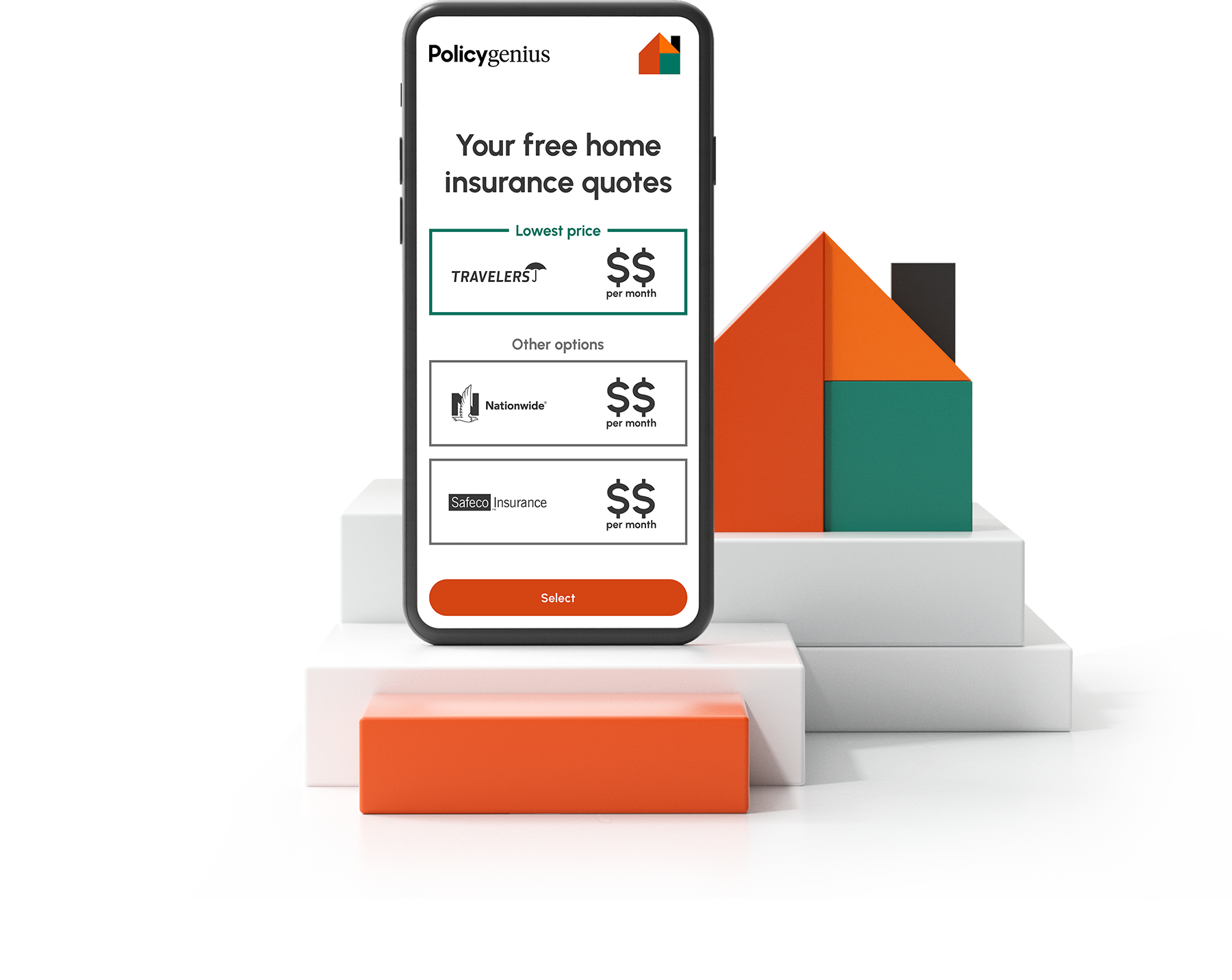Understanding how much home insurance you need
Purchasing a house can be a risky investment given the unpredictability of the market and Mother Nature. Fortunately, with the right amount of homeowners insurance, you have the peace of mind knowing your house and livelihood are covered in case of the unexpected.
In short, homeowners insurance should cover:
The cost to rebuild your home
The cost to replace your personal belongings
The combined value of your assets
Temporary living costs if your home is destroyed
In this guide, we’ll help you choose the right amount of coverage to ensure your house and finances are fully protected.
How much homeowners insurance should I have?
While you can technically purchase whatever amount of homeowners insurance meets the coverage “minimums" required by your insurer or lender, that likely won’t be enough to adequately protect your house and other areas of your life.
Here’s a breakdown of minimum coverage limits, our recommended coverage limits, and optional policy enhancements for each of the six standard homeowners insurance coverages.
Coverage type | Minimum coverage limits | How much coverage you need | Optional coverage upgrades* |
The minimum amount required by the insurer or your mortgage lender | An amount equal to the home's replacement cost, which is the cost to rebuild to the home's original specifications | Extended replacement cost, guaranteed replacement cost, inflation guard, ordinance or law | |
10% of dwelling coverage limit | 10% to 20%, or whatever amount covers the replacement cost of additional structures on your property | Optional dwelling coverages also apply to additional structures on your property | |
50% of dwelling coverage limit | 50% to 70%, or whatever amount covers the cost of replacing all of your belongings | Replacement cost contents, open perils coverage, scheduled personal property | |
20% of dwelling coverage limit | 20% to 30%, but you should have enough to cover additional living expenses for up to a year | Unlimited loss of use coverage | |
$100,000 | $300,000 to $500,000, but you'll want at least enough to cover the combined value of your assets | Personal umbrella policy, personal injury protection, home business protection | |
$1,000 | $3,000 to $5,000, but you may want to consider higher limits if you have liability risks on your property | $10,000 or $25,000 limits |
Availability of optional coverages can vary by state and insurance company.
How much dwelling coverage do I need?
Dwelling coverage is the part of your home insurance policy that covers the cost to rebuild your home in case it’s damaged or destroyed by a fire, severe storm, or another covered peril. To determine how much dwelling coverage you need, you’ll have to get the home’s replacement cost, or the cost to rebuild it using materials of similar type and quality at today’s prices.
Learn more >> 9 home insurance myths — debunked
How do I calculate my home’s replacement cost?
Replacement cost is only based on factors that impact the home’s reconstruction value, such as square footage, construction style, number of rooms, and local building costs in your area. It does not take the home’s market value or the value of the land into consideration.
Here’s how to get a rough estimate of your home’s replacement cost.
Multiply the square footage of the home by the cost of building materials per square foot in your area, while also considering the cost of built-in appliances and fixtures in the home. [1] Or contact a local construction company for an estimate.
Use an online home insurance calculator or replacement cost estimator, like the Policygenius home insurance calculator below.
Get home insurance quotes or talk to an independent insurance agent for an estimate. Most major insurance providers now use their own replacement cost estimator software to provide coverage recommendations — and they’re often fairly accurate. If you go with this option, get home insurance quotes from multiple companies to make sure you are getting the best rate.
Keep in mind that, while most insurance calculators are free, you may be asked to pay if you want a more thorough estimate.
What factors can impact my home’s replacement cost?
A home’s replacement cost can vary based on when it was built, where it was built, and several other factors listed below.
Local construction and labor costs
The age of your home
Your home's square footage
Number of bathrooms and other rooms
The architectural style of your home
Special architectural features specific to your home, like a fireplace, crown molding, arched windows, etc
Home renovations or upgrades
Remember that, over time, changes to things like construction costs or recent renovations can necessitate higher coverage limits for your home.
Learn more >>How to estimate home replacement cost
How to insure your house against inflation
In an era of expensive climate disasters, above-average inflation, and rising replacement costs, there’s a chance your policy’s dwelling coverage limits may not be high enough to cover the cost to rebuild your home to its original condition.
According to our Policygenius Home Insurance & Inflation Shopping Survey, only 33% of homeowners are "very sure" their home's coverage limit is high enough to cover their home's entire rebuild cost.
Your insurance expert can help you find out if valuable policy add-ons or additional dwelling protection are available in your area, like:
Extended replacement cost: In the event your home is destroyed and rebuild costs are higher than the dwelling coverage limit in your policy, this extended replacement cost coverage extends your limits to cover the increased costs, typically up to 25% or 50%, depending on your policy.
Guaranteed replacement cost: This covers the full cost of rebuilding your home after a disaster, regardless of the cost. Guaranteed replacement cost is similar to extended replacement coverage in that it's triggered by spikes in construction costs — the difference being there isn't a cap or limit to how much it will pay out.
Inflation guard: This automatically increases your dwelling coverage limit each year to keep pace with inflation.
Ordinance or law: This covers the increased cost of rebuilding your home to comply with local building codes and ordinances.
These coverage add-ons are both limited by company and state. If interested, reach out to your insurance agent to see if it’s offered where you live, or shop policy options from multiple home insurance companies.
How much personal property coverage do I need?
Your personal property coverage limit should be high enough to cover the total value of your belongings, aka your furniture, electronics, and anything else you consider your “stuff.” By default, personal property coverage limits are set at 50% of your dwelling coverage limit, but most insurers offer a 70% option for an additional fee.
Here are some effective ways to calculate the value of your belongings, increase your reimbursement amount, and increase coverage limits on expensive valuables or precious heirlooms with lower limits of liability.
1. Take a home inventory
A home inventory is a detailed list of all of your personal possessions — as well as their cost. It gives you a better idea of how much personal property coverage you need. And bonus: You’ll have records of your belongings if you need to file a claim.
2. Consider replacement cost contents coverage
Standard home insurance policies protect your personal property at its actual cash value, meaning depreciation is subtracted from your total reimbursement amount on a claim. But many insurers will give you the option of upgrading your coverage to replacement cost, which doesn’t factor depreciation into your payout. While you typically have to pay an additional fee for this coverage, it’s often worth it.
3. Consider additional coverage for jewelry and other expensive valuables
Insurers limit how much they’ll pay out for certain high-value items like expensive jewelry, art, and electronics. For example, a standard policy will only cover jewelry up to $2,500 per theft loss. Check with your insurance company to see if they offer a scheduled personal property endorsement to increase your coverage limits on specific valuables.
How much liability insurance do I need?
Your liability coverage limit should be high enough to cover the financial value of your assets, such as the value of your home, car, possessions, cash on hand, savings, and anything else of yours that holds value. That means if you have $400,000 in assets, you should have at least $400,000 in personal liability coverage to ensure you’re fully protected.
Liability coverage helps pay for legal or medical expenses if you’re legally responsible for an injury or property damage. For example, if you’re held liable for an injury to a house guest, personal liability coverage can help cover their medical bills, legal fees if they decide to sue, and other liability expenses that you’d otherwise be responsible for covering out of pocket. If the settlement amount exceeds your liability coverage limit, the plaintiff may be entitled to go after your assets until this amount is reached.
How much loss of use coverage do I need?
If you can’t live in your home due to covered disaster, you’ll want enough loss of use coverage to cover the cost of hotel bills, restaurant meals, and other expenses required for you to maintain your normal standard while your home is being rebuilt or repaired.
Your loss of use coverage limit defaults to 20% of your dwelling coverage limit, but your insurance provider may offer higher limits (or even unlimited coverage) for an additional fee. If your home is located in an area prone to natural disasters where total losses aren’t uncommon, it may be worth opting for higher coverage limits.
You can calculate how much additional living expenses coverage you need by adding up how much you spend on living expenses like food, rent, and gas in a typical month.
What is not covered by homeowners insurance?
Homeowners insurance excludes certain disasters from coverage, including flooding, earthquakes, and water damage from sump pump or sewer line backups. To ensure you’re fully protected, consider additional insurance coverage or policy endorsements.
Flood insurance
While homeowners insurance covers some causes of water damage — like a burst pipe — it doesn’t cover flood damage. Even if you don't live in an area that’s at high risk for flooding, you should still consider purchasing a standalone flood insurance policy anyway.
Why? Because 25% of all flood losses occur in low-risk areas, according to the Insurance Information Institute. [2]
Homeowners who live in flood zones may also be required by their mortgage lender to have a flood insurance policy in addition to their regular home insurance.
Learn more >> How does flood insurance work?
Earthquake insurance
Earthquake damage isn’t covered by a standard home insurance policy, but you may be able to add an earthquake endorsement to your current homeowners insurance policy.
Otherwise, you might want to consider purchasing a standalone earthquake insurance policy — even if you don't think earthquakes are a problem where you live.
Why? Because as many as half of Americans are exposed to a potentially dangerous quake, and that number is likely higher in earthquake-prone states like California, Nevada, and Oklahoma, according to the U.S. Geological Survey. [3]
Learn more >> Is earthquake insurance worth the cost?
Water backup coverage
Damage from water that backs up through your drains or sewers or overflows from a sump pump isn’t typically covered by a regular homeowners insurance policy or flood insurance policy. [4] If you want protection from this type of water damage, you can add water backup coverage as an endorsement to your policy.
Learn more >> How does water backup coverage work?





